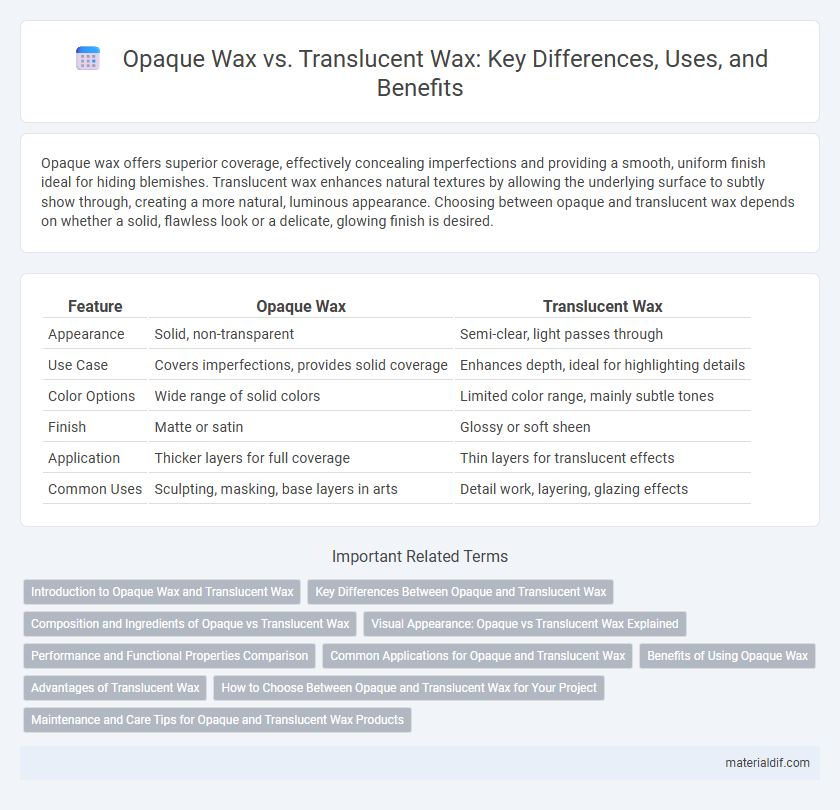Opaque wax offers superior coverage, effectively concealing imperfections and providing a smooth, uniform finish ideal for hiding blemishes. Translucent wax enhances natural textures by allowing the underlying surface to subtly show through, creating a more natural, luminous appearance. Choosing between opaque and translucent wax depends on whether a solid, flawless look or a delicate, glowing finish is desired.
Table of Comparison
| Feature | Opaque Wax | Translucent Wax |
|---|---|---|
| Appearance | Solid, non-transparent | Semi-clear, light passes through |
| Use Case | Covers imperfections, provides solid coverage | Enhances depth, ideal for highlighting details |
| Color Options | Wide range of solid colors | Limited color range, mainly subtle tones |
| Finish | Matte or satin | Glossy or soft sheen |
| Application | Thicker layers for full coverage | Thin layers for translucent effects |
| Common Uses | Sculpting, masking, base layers in arts | Detail work, layering, glazing effects |
Introduction to Opaque Wax and Translucent Wax
Opaque wax is a type of finishing wax that conceals the underlying surface by providing a solid, non-transparent layer, making it ideal for covering imperfections or changing the color of wood or painted surfaces. Translucent wax allows the natural texture and color of the surface to show through while enhancing protection and adding a subtle sheen, often used to preserve the original look with minimal alteration. Both waxes serve specific purposes in furniture restoration and decorative finishes, with opaque wax offering coverage and translucent wax emphasizing preservation.
Key Differences Between Opaque and Translucent Wax
Opaque wax creates a solid, non-see-through finish that hides surface imperfections, making it ideal for covering flaws on furniture or decorative items. Translucent wax allows the underlying surface texture and color to show through while adding a subtle protective layer and enhancing the natural look. The primary difference lies in coverage and aesthetic effect: opaque wax obscures details whereas translucent wax highlights and preserves the original finish.
Composition and Ingredients of Opaque vs Translucent Wax
Opaque wax typically contains higher concentrations of pigments and fillers such as titanium dioxide, which provide dense coverage and mask underlying surfaces, while translucent wax has fewer pigments and includes more resins and oils to enhance clarity and depth. The compositional difference influences their finish; opaque waxes create a solid, matte layer, whereas translucent waxes allow light to pass through, accentuating wood grain and texture. Both wax types generally use natural or synthetic wax bases like carnauba or beeswax, but variations in additives determine their opacity and protective qualities.
Visual Appearance: Opaque vs Translucent Wax Explained
Opaque wax offers a solid, matte finish that effectively conceals surface imperfections and provides a uniform color, making it ideal for covering blemishes on wood furniture. Translucent wax enhances the natural grain by allowing the underlying color and texture to show through, resulting in a subtle sheen that highlights the wood's character. Choosing between opaque and translucent wax depends on whether you want to mask flaws or accentuate the original appearance of the surface.
Performance and Functional Properties Comparison
Opaque wax offers superior coverage, effectively hiding surface imperfections and providing a solid, uniform finish ideal for restoration projects. Translucent wax excels in enhancing depth and natural sheen, allowing the underlying surface texture and color to subtly show through while offering water resistance and protective sealing. Performance-wise, opaque wax is preferred for blemish concealment, whereas translucent wax is valued for its ability to enrich and preserve the original appearance without masking details.
Common Applications for Opaque and Translucent Wax
Opaque wax is commonly used for hiding imperfections and filling in small gaps on wood surfaces, providing a solid, uniform finish ideal for furniture restoration and decorative crafts. Translucent wax enhances the natural grain of wood or painted surfaces, offering a protective layer while preserving the underlying color, making it popular for fine woodworking, art finishing, and antique preservation. Both types of wax serve essential roles in finishing projects, with opaque wax favored for coverage and translucent wax chosen for subtle protection and enhancement.
Benefits of Using Opaque Wax
Opaque wax offers superior coverage by effectively hiding imperfections, scratches, and stains on wooden surfaces, ensuring a smooth and uniform finish. Its thicker consistency provides enhanced protection against moisture and wear, extending the durability of furniture and floors. Ideal for restoration projects, opaque wax revitalizes aged wood while maintaining a matte or satin appearance without altering the underlying color.
Advantages of Translucent Wax
Translucent wax offers superior color accuracy by allowing the natural hues of the underlying surface to shine through, making it ideal for fine art and intricate wood finishes. Its clarity enhances depth and richness without altering the original tone, providing a more refined and subtle protective layer. Unlike opaque wax, translucent wax preserves details and textures while delivering excellent durability and moisture resistance.
How to Choose Between Opaque and Translucent Wax for Your Project
Choosing between opaque and translucent wax depends on the desired finish and surface characteristics of your project. Opaque wax provides solid, matte coverage ideal for concealing imperfections and adding a vintage or distressed look, while translucent wax enhances color depth and highlights natural textures without masking the base coat. Assess your project's color scheme and texture visibility to select the wax type that best complements your artistic intent and surface condition.
Maintenance and Care Tips for Opaque and Translucent Wax Products
Opaque wax requires more frequent polishing to maintain its solid coverage and avoid dullness, while translucent wax benefits from lighter, less frequent applications to preserve its natural sheen. Both types demand cleaning surfaces thoroughly before application to ensure optimal adhesion and longevity. Store wax products in a cool, dry place to prevent softening or hardening, which can affect performance.
Opaque Wax vs Translucent Wax Infographic

 materialdif.com
materialdif.com